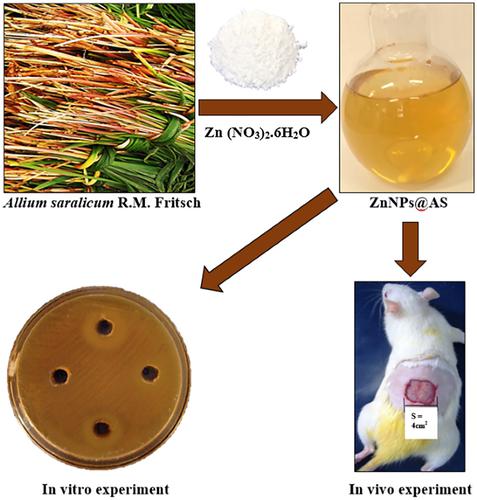当前位置:
X-MOL 学术
›
Appl. Organomet. Chem.
›
论文详情
Our official English website, www.x-mol.net, welcomes your feedback! (Note: you will need to create a separate account there.)
Biosynthesis of zinc nanoparticles using Allium saralicum R.M. Fritsch leaf extract; Chemical characterization and analysis of their cytotoxicity, antioxidant, antibacterial, antifungal, and cutaneous wound healing properties
Applied Organometallic Chemistry ( IF 3.9 ) Pub Date : 2020-02-24 , DOI: 10.1002/aoc.5564 Chunnan Zhang 1 , Jiayu Liu 2 , Ahmad Ahmeda 3 , Yandong Liu 1 , Jianyu Feng 1 , Hui Guan 1 , Cuiyun Li 2 , Masoumeh Nowrozi 4 , Mohammad Mahdi Zangeneh 4, 5 , Akram Zangeneh 4, 5 , Maryam Almasi 4
Applied Organometallic Chemistry ( IF 3.9 ) Pub Date : 2020-02-24 , DOI: 10.1002/aoc.5564 Chunnan Zhang 1 , Jiayu Liu 2 , Ahmad Ahmeda 3 , Yandong Liu 1 , Jianyu Feng 1 , Hui Guan 1 , Cuiyun Li 2 , Masoumeh Nowrozi 4 , Mohammad Mahdi Zangeneh 4, 5 , Akram Zangeneh 4, 5 , Maryam Almasi 4
Affiliation

|
The extract of Allium saralicum R.M. Fritsch leaf was found to be an effective reagent for green synthesis and functionalization of zinc nanoparticles (ZnNPs@AS) from 1 mM zinc acetate solution. These nanoparticles were characterized by fourier-transform infrared spectroscopy (FT-IR), X-ray powder diffraction (XRD), ultraviolet–visible spectroscopy (UV–Vis), field emission scanning electron microscopy (FE-SEM), and transmission electron microscopy (TEM) analysis. FT-IR results offered polysaccharides and protein in A. saralicum were the sources of reducing power, reducing zinc ions to ZnNPs@AS. In XRD analysis, the crystal size of zinc nanoparticles was 19.7 nm. TEM and FE-SEM images indicated the average diameter of 19 nm for the zinc nanoparticles. For investigating the antimicrobial properties of Zn (NO3)2.6H2O, A. saralicum, and ZnNPs@AS, we used the macro-broth dilation test. Also, MIC, MBC, and MFC of Zn (NO3)2.6H2O, A. saralicum, and ZnNPs@AS were gained to indicate the exact antimicrobial potentials of them. ZnNPs@AS indicated higher antifungal and antibacterial effects than all standard antibiotics (p ≤ 0.01). The MIC of ZnNPs@AS were 2–4 and 2–8 mg/mL against fungi and bacteria, respectively. But, MBC and MFC of ZnNPs@AS were 4–8 mg/mL against all fungi and bacteria tested. To survey the cutaneous wound healing effects of Zn (NO3)2.6H2O, A. saralicum, and ZnNPs@AS, the 0.2% ointments were formulated and compared with the control and untreated groups. The use of ZnNPs@AS ointment significantly (p ≤ 0.01) raised the wound contracture, vessel, hydroxyl proline, hexuronic acid, hexosamine, fibrocyte, fibroblast, and fibrocytes/fibroblast rate and significantly (p ≤ 0.01) decreased the wound area, total cells, neutrophil, macrophage, and lymphocyte compared to other groups in rats. According to the above findings, ZnNPs@AS may be consumed for the treatment of cutaneous wounds and infectious diseases in humans.
中文翻译:

使用Allium saralicum RM Fritsch叶提取物生物合成锌纳米颗粒;其细胞毒性、抗氧化、抗菌、抗真菌和皮肤伤口愈合特性的化学表征和分析
发现Allium saralicum RM Fritsch 叶提取物是一种有效的试剂,可用于从 1 mM 醋酸锌溶液中绿色合成和功能化锌纳米颗粒 (ZnNPs@AS)。这些纳米颗粒通过傅里叶变换红外光谱 (FT-IR)、X 射线粉末衍射 (XRD)、紫外-可见光谱 (UV-Vis)、场发射扫描电子显微镜 (FE-SEM) 和透射电子显微镜进行了表征(TEM) 分析。FT-IR 结果提供了苦参中的多糖和蛋白质是还原能力的来源,将锌离子还原为 ZnNPs@AS。在XRD分析中,锌纳米颗粒的晶体尺寸为19.7 nm。TEM 和 FE-SEM 图像表明锌纳米粒子的平均直径为 19 nm。为了研究 Zn (NO 3 ) 2 .6H 2 O、A. saralicum和 ZnNPs@AS 的抗菌性能,我们使用了大肉汤膨胀试验。此外,还获得了 Zn (NO 3 ) 2 .6H 2 O、A. saralicum和 ZnNPs@AS 的MIC、MBC 和 MFC,以表明它们的确切抗菌潜力。ZnNPs@AS 显示出比所有标准抗生素更高的抗真菌和抗菌作用(p≤ 0.01)。ZnNPs@AS 对真菌和细菌的 MIC 分别为 2-4 和 2-8 mg/mL。但是,对于所有测试的真菌和细菌,ZnNPs@AS 的 MBC 和 MFC 为 4-8 mg/mL。为调查 Zn (NO 3 ) 2 .6H 2 O、A. saralicum和 ZnNPs@AS 的皮肤伤口愈合效果,配制 0.2% 软膏并与对照组和未治疗组进行比较。使用 ZnNPs@AS 软膏显着提高创面挛缩、血管、羟脯氨酸、己糖醛酸、己糖胺、成纤维细胞、成纤维细胞和成纤维细胞/成纤维细胞率,并显着( p≤ 0.01) 与其他组相比,大鼠的伤口面积、总细胞、中性粒细胞、巨噬细胞和淋巴细胞减少。根据上述发现,ZnNPs@AS 可用于治疗人类皮肤伤口和传染病。
更新日期:2020-02-24
中文翻译:

使用Allium saralicum RM Fritsch叶提取物生物合成锌纳米颗粒;其细胞毒性、抗氧化、抗菌、抗真菌和皮肤伤口愈合特性的化学表征和分析
发现Allium saralicum RM Fritsch 叶提取物是一种有效的试剂,可用于从 1 mM 醋酸锌溶液中绿色合成和功能化锌纳米颗粒 (ZnNPs@AS)。这些纳米颗粒通过傅里叶变换红外光谱 (FT-IR)、X 射线粉末衍射 (XRD)、紫外-可见光谱 (UV-Vis)、场发射扫描电子显微镜 (FE-SEM) 和透射电子显微镜进行了表征(TEM) 分析。FT-IR 结果提供了苦参中的多糖和蛋白质是还原能力的来源,将锌离子还原为 ZnNPs@AS。在XRD分析中,锌纳米颗粒的晶体尺寸为19.7 nm。TEM 和 FE-SEM 图像表明锌纳米粒子的平均直径为 19 nm。为了研究 Zn (NO 3 ) 2 .6H 2 O、A. saralicum和 ZnNPs@AS 的抗菌性能,我们使用了大肉汤膨胀试验。此外,还获得了 Zn (NO 3 ) 2 .6H 2 O、A. saralicum和 ZnNPs@AS 的MIC、MBC 和 MFC,以表明它们的确切抗菌潜力。ZnNPs@AS 显示出比所有标准抗生素更高的抗真菌和抗菌作用(p≤ 0.01)。ZnNPs@AS 对真菌和细菌的 MIC 分别为 2-4 和 2-8 mg/mL。但是,对于所有测试的真菌和细菌,ZnNPs@AS 的 MBC 和 MFC 为 4-8 mg/mL。为调查 Zn (NO 3 ) 2 .6H 2 O、A. saralicum和 ZnNPs@AS 的皮肤伤口愈合效果,配制 0.2% 软膏并与对照组和未治疗组进行比较。使用 ZnNPs@AS 软膏显着提高创面挛缩、血管、羟脯氨酸、己糖醛酸、己糖胺、成纤维细胞、成纤维细胞和成纤维细胞/成纤维细胞率,并显着( p≤ 0.01) 与其他组相比,大鼠的伤口面积、总细胞、中性粒细胞、巨噬细胞和淋巴细胞减少。根据上述发现,ZnNPs@AS 可用于治疗人类皮肤伤口和传染病。



























 京公网安备 11010802027423号
京公网安备 11010802027423号